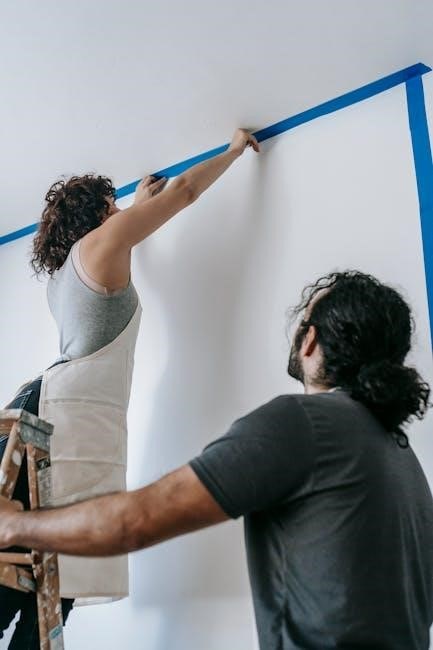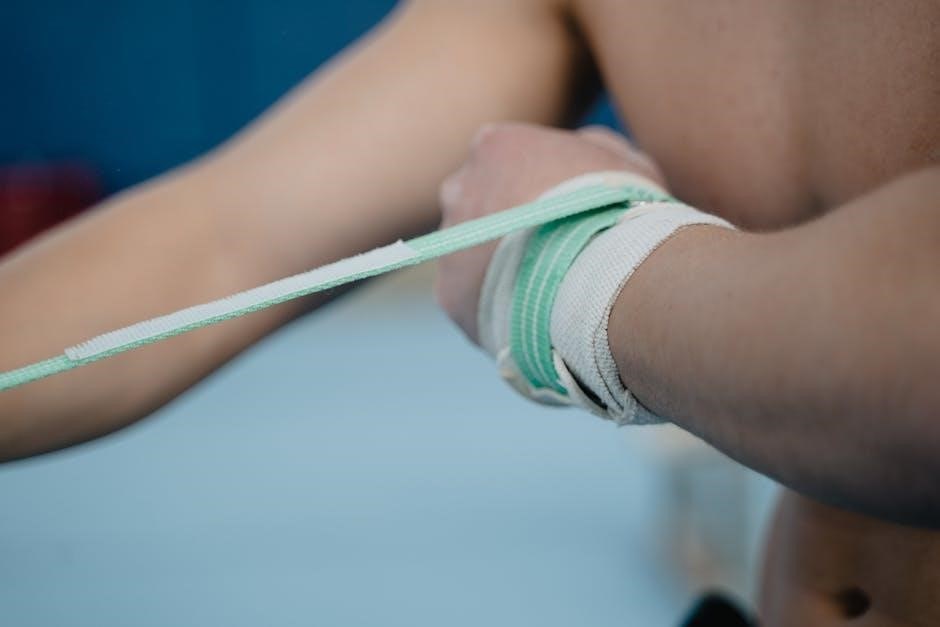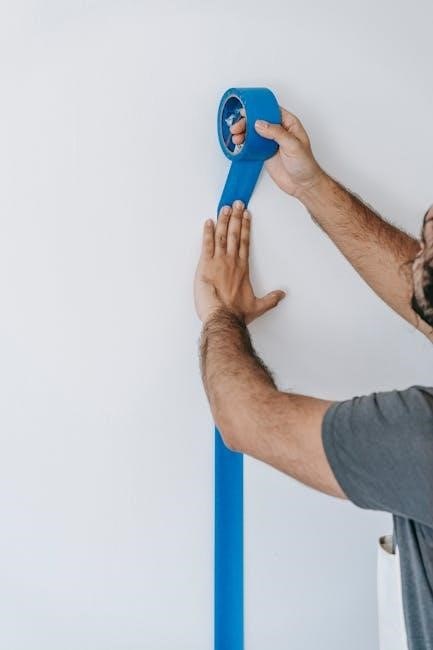
plantar fasciitis taping pdf
Plantar fasciitis taping is a popular treatment method using tapes to reduce pain and stress on the plantar fascia, providing relief and support to affected areas constantly․
What is Plantar Fasciitis Taping
Plantar fasciitis taping is a therapeutic technique used to alleviate pain and discomfort associated with plantar fasciitis, a common condition affecting the heel and bottom of the foot․ This method involves applying specialized tape to the foot to provide support and stability, reducing stress on the plantar fascia․ The tape is typically applied in a specific pattern to help redistribute pressure and alleviate tension on the affected area․ By using plantar fasciitis taping, individuals can experience relief from pain and discomfort, allowing them to resume daily activities with greater ease․ The technique is often used in conjunction with other treatments, such as stretching and orthotics, to provide comprehensive relief from plantar fasciitis symptoms․ Overall, plantar fasciitis taping is a non-invasive and effective treatment option for managing plantar fasciitis․ It is a simple yet effective solution for pain relief․

Benefits of Plantar Fasciitis Taping
Plantar fasciitis taping provides pain relief and reduces stress constantly every day․
Reduction of Pain and Stress
Plantar fasciitis taping is used to reduce pain and stress on the plantar fascia, providing relief and support to affected areas․ The tape helps to reduce tension on the fascia, allowing it to heal and reducing pain․ This method is often used in conjunction with other treatments, such as stretching and orthotics․ By reducing pain and stress, plantar fasciitis taping can help individuals to return to their normal activities and improve their overall quality of life․ The reduction of pain and stress is a key benefit of plantar fasciitis taping, making it a popular treatment option for those suffering from this condition․ Overall, plantar fasciitis taping is a simple and effective way to reduce pain and stress, promoting healing and recovery․ The use of tape can be tailored to individual needs, making it a versatile treatment option․

Taping Techniques for Plantar Fasciitis
Various taping methods are applied to alleviate plantar fasciitis symptoms effectively always using tapes․
Windlass Taping and Low-Dye Taping
Windlass taping and Low-Dye taping are two commonly used techniques for plantar fasciitis treatment, with Windlass taping focusing on reducing stress on the plantar fascia and Low-Dye taping supporting the arch․
These techniques involve applying tape to specific areas of the foot to alleviate pain and discomfort, with Windlass taping being used to take pressure off the plantar fascia and Low-Dye taping helping to reduce stress on the foot․
The goal of these taping techniques is to provide relief and support to the affected area, allowing patients to manage their symptoms and improve their overall quality of life, and they can be used in conjunction with other treatments, such as stretching and orthotics, to achieve optimal results․
Taping techniques like Windlass and Low-Dye can be effective in reducing pain and stress on the plantar fascia, and are often used by physical therapists and healthcare professionals to treat plantar fasciitis․

Comparison of Taping Techniques
Comparing different taping techniques helps determine effectiveness in plantar fasciitis treatment always using specific methods correctly․
Dynamic Tape versus Low-Dye Taping
Research has been conducted to compare the effectiveness of dynamic tape and low-dye taping in treating plantar fasciitis, with studies showing varying results․ The dynamic tape method involves applying a specific type of tape to the affected area, while low-dye taping uses a different technique to support the foot․ Both methods aim to reduce pain and stress on the plantar fascia, but the dynamic tape method has been shown to be more effective in some cases․ A randomized clinical trial compared the two methods and found that dynamic tape was more effective in reducing pain and improving function․ However, more research is needed to fully understand the benefits and drawbacks of each method, and to determine which is most effective for individual patients․ Overall, the choice of taping method depends on the specific needs and circumstances of each patient․
Effectiveness of Plantar Fasciitis Taping
Plantar fasciitis taping is effective in reducing pain and stress, providing relief constantly and quickly․
Studies and Research on Taping Techniques
Research has been conducted to investigate the effects of various taping techniques on plantar fasciitis, including windlass taping and low-dye taping․
Studies have shown that these techniques can be effective in reducing pain and stress on the plantar fascia․
A 2020 study found that a home-based stretching program was effective in treating plantar fasciitis, and taping techniques can be used in conjunction with such programs․
The use of dynamic tape versus low-dye taping has also been compared in a randomized clinical trial, with results showing that both techniques can be effective․
Overall, the research suggests that taping techniques can be a useful adjunct to other treatments for plantar fasciitis, and can help to provide relief from pain and stress․
Further research is needed to fully understand the effects of taping techniques on plantar fasciitis․
Taping techniques can be used to promote a healing environment and enhance patient care․

Application and Instruction of Plantar Fasciitis Taping
Plantar fasciitis taping application requires proper instruction and technique guidance always․
Step-by-Step Guide to Taping Techniques
A step-by-step guide to taping techniques for plantar fasciitis is essential for effective treatment, providing a clear understanding of the process and its benefits․
The guide should include detailed instructions on how to apply the tape, including the correct placement and tension․
It should also cover the different types of tape that can be used, such as athletic tape or kinesiology tape, and their specific applications․
Additionally, the guide should provide tips on how to remove the tape safely and comfortably, and how to care for the skin after taping․
By following a step-by-step guide, individuals can ensure that they are using taping techniques correctly and safely, and can maximize the benefits of this treatment for plantar fasciitis․
The guide can be found in various online resources, including plantar fasciitis taping pdf files․
Leave a Reply
You must be logged in to post a comment.